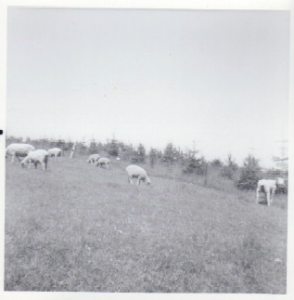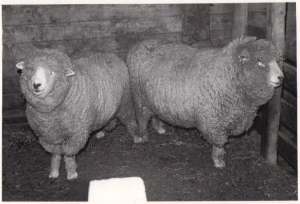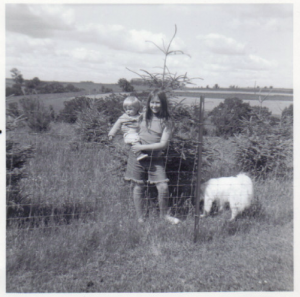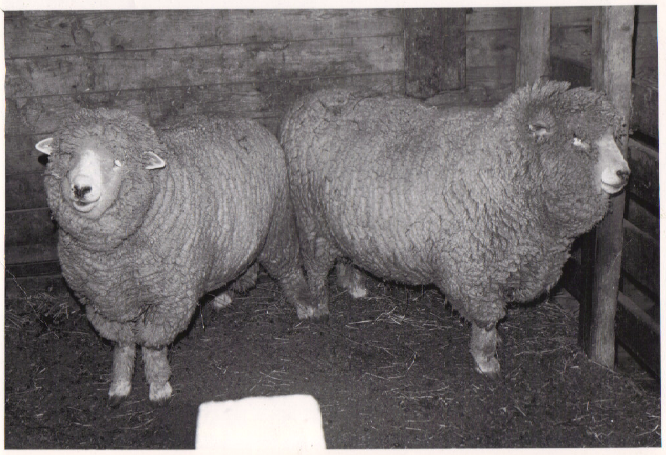The truth is, I knew next to nothing about building a fence. As a child, I had seen fences being built on my Grandpa’s farm, and as well as I could remember they consisted of big wooden posts, for which a hole had to be dug, and they were then strung with several strands of barbed wire.
Most of the scattered fence sections we had been trying to remove from our pastures were made up of metal “T” posts and wire netting. The posts were reusable, as was some of the netting, but there simply wasn’t enough of either.
My sister, Merle, who had been dairy farming for a dozen years knew a lot more about fencing than I, so I turned to her for help. She not only had some left over wire netting I could use but she also loaned me a maul, and something she called a “sleeve.”
I knew the maul was to drive posts into the ground, but I wasn’t exactly sure what part the “sleeve” played in all this. Nevertheless, I hauled it all home and set about building the fence.
Building the Fence

My fence would start at the gate, run past a huge White Oak tree, which would be in the pasture and provide shade, and then parallel the old fence until it reached the southeast corner of the fence around the yard. The area to be enclosed was about 150 feet by 200 feet, more than enough pasture for two sheep.
OK, time to set the first “T” post.
Propping up the post with my left hand, and grasping the long handled maul in the other, I attempted to lift the maul and hit the top of the post.
This did not go well.
The post was too tall, I was too short, and the maul was too heavy!
Next, I tried holding the post at an angle and then hitting it with the maul. After several tries, I did get the post in the ground a short way, but of course it was at an unacceptable angle.
I pushed on it to straighten it a bit; then hit it with the maul. The maul just glanced off the skinny “T” post and I only succeeded in knock it over.
This was not going to be easy!
As I stared dejectedly at the fruits of my labor, my eye fell on the “sleeve” lying nearby. It was a heavy metal tube about 3 feet long, closed at one end and open at the other.
“Ah!” I thought, “That must be it! You put this over the top of the ‘T’ post and you have something to hit with the maul.” After struggling with this method for some time, I managed to get two posts in the ground. My arms, however, felt like they were being torn out of their sockets and I ached all over.
I sat down on the ground and surveyed the scene; it was clear to me that at that rate I was never going to get the fence built.
As I sat there staring at the two posts, a light began to come on! “Maybe, you just put the sleeve on the post, lift it up and drop it, and that drives the post in.” With that, I leaped to my feet and tried this new tactic.
Hallelujah! It worked!! Although building that fence was still quite a challenge, I got it done, our sheep were safely enclosed, and life went on more peacefully.
Ewe Need a Ram

As fall approached, I began to consider that I needed a ram to breed my ewes. But, what kind of ram?
The market price for sheep and lambs was low at that time, however wool prices were high for the better grades. Most of these were the fine wools produced by white-faced sheep raised in the Western U.S. Midwest flocks were then mostly black-faced, meat-type sheep. These had much less wool, it was of a coarser grade, and it contained black fibers that would not take dye. This kind of wool was all lumped together in a category called “fleece wools” and sold at a much lower price per pound than the fine wools of the Western flocks.
In addition to the price the farmer received on the market there was an incentive for wool because, following World War II, the government decided they would never be without a source of wool for uniforms.
It was widely believed that Germany lost the war on the Russian front because their troops lacked wool uniforms, could not withstand the extreme cold, and many froze to death. Russia, being a huge wool producing country, had plenty of wool for uniforms, and their troops were able to survive the frigid temperatures.
Thus, the “Wool Act” was passed and farmers received an incentive based on the type of wool produced. The fine wool grades received the largest payments, and the “fleece wools” from farm flocks received lesser amounts.
Considering all this, I came to the conclusion that I should raise fine wool sheep. I knew someone in the area who had a flock of Corriedales, which is a breed known for their excellent fine wools and extremely heavy fleeces.
I contacted the owners and found they had an older ram that they would consider selling. As I only had two ewes, I figured an older ram could very likely be counted on to breed them. So I bought him and a date was set for him to be delivered.
Our barn, which had been standing empty for some years, needed some work. No problem! A hammer and some nails could make it habitable enough for our small flock. Now that I was getting a ram, I wanted to be able to house him in the barn, away from the ewes until breeding time.
Our barn had a north door that faced the house and this was the door we used on most occasions. The south side of the barn had two doors; an upper level door for the main barn and a lower level door for the lower barn, which had apparently been a horse barn originally.
The door to the main barn was in good shape and could be tightly shut and locked by a bar that dropped into place on the outside of the door. The lower barn door, however, was a little less substantial and had a fairly wide gap that needed to be closed. Jerry found a good solid board that, though it would not completely cover the gap, covered enough so no sheep could get through it. Since we hadn’t anticipated using that door until the following spring, he nailed it firmly in place, leaving about a 4 1/2 inch gap.
Me and My Shadow
Shortly thereafter, the ram was delivered.
We opened the upper level door and unloaded him into the main barn, then shut and locked the door from the outside. I went around to the other side and entered the barn, closed a Dutch-style inner door, but left the heavy outer barn door open so I could exit the barn when I was ready.
I proceeded to look over my new ram; he seemed very satisfactory, good sized, and had a beautiful white fleece. I gave him some hay and filled the water tank with fresh water. As I moved about the barn the ram followed directly behind me.
That made me a bit apprehensive; rams are generally not to be trusted. I even tried a ploy of going through the manger, thinking that would distract him, but he followed me through there too.
Wherever I went, he went. Finally, everything was finished and I was ready to leave, when a sudden strong northeast wind came up and slammed the big North door closed with such force that the locking bar on the outside fell into place.
I was locked in! Just me and the ram!
The other upper level door to the south was also locked from the outside, so I decided to check the door on the lower barn level, the one that Jerry had nailed shut.
Whoever had last used the lower barn had apparently used it for manure storage; it was piled up high enough so that one could just walk down the slope of the pile to get to the lower barn floor. I thought this would surely deter the ram, but it did not.
He doggedly followed me there too.
After I checked the gap in the door, I decided there was no way I could get out through there. So back up the manure slope we went.

There was a small four-paned window above the north barn door, and I thought that if I climbed up there I might possibly get Lisa’s attention since she was in the house. I perched on top of a shaky stepladder for a long time, and stared out the window to no avail. The ram looked up at me expectantly from below.
I came to the conclusion that I was just going to have to get out that lower barn door, somehow! So, back I went to the lower barn – followed by the ram. I convinced myself that I not only must – but could – get through that gap. I was slim, but not skinny, and weighed about 110 pounds. I took a deep breath, made myself as small as possible, and somehow squeezed my way out.
I may have left some skin there, but I was out.
After that, every time I went to the barn to feed and water the ram, we went through the same routine. He was never aggressive; he just followed in my footsteps the whole time.
It may be impossible to teach an old ram new tricks, but a new shepherdess can learn. I accepted his strange behavior and stopped worrying.


Aunt Lea,
Reading this chapter has been so entertaining. Where was your cell phone when you needed it? Oh, that’s right, we didn’t have them then. Your life raising sheep is amazing and makes me feel like I have certainly enjoyed a “pampered” life as a city dweller. You must have come from sturdy stock!
Looking forward to the next installment. Your little comments have definitely wet our appetites.
LaDon
LaDon,
Glad you are enjoying the stories, and I am enjoying them myself, as I relive all those memories. Very glad I kept journals! Those, plus all the lambing records over the years, and old photos, all help put the stories together… even the old “Round Robin” from years past can contribute some nuggets.
You see, I always thought I would write a book someday. But, when? I needed to be prodded into it… sort of like this little ditty I stumbled onto once, which is so descriptive.
“The guilt of not answering letters
Weighs down on my conscience at night.
I suffer and groan in the silence,
But nothing can force me to write.”
Thanks for the comments, LaDon, they are much appreciated!
Aunt Lea
Lea
I really enjoyed your story. Looking forward to more.
Gloria
Gloria,
Thank you for your comment. We hope to keep you entertained as the story progresses. You can look forward to our very first lambing, in which a green horn shepherdess locks horns with a wily old ewe. A learning experience to be sure, and “it ain’t pretty”!
Lea
Oh, my! I laughed and laughed while you were building your fence! While I could have NEVER done all you have, it reminded me of the winter I was a ‘lumberjackass’! You paint such wonderful word pictures of all the different aspects of farm life with your sheep. Keep those fingers movin’ and the keyboard smokin’!
Hi Naomi,
So, you’re laughing at my foibles! Bet you can’t come close to my brother- in-law, Bart. He fell off his chair laughing! And then said, if that was him, he wouldn’t have told that story to anybody! Oh well, I like to share the wealth, and I have plenty more foibles where that one came from!
When you make as many typos as I do, it is hard to ‘keep the keyboard smokin’, but I will do my best. Thanks for your comment, and keep cheering me on, it helps!
Lea
Wow, I never knew about WWII and the wool uniforms-that is very interesting. It is great you are writing all this down as my generation and younger really do not know all the work and time that goes into running a farm. I enjoy reading your stories and your humor adds a nice touch. Did you give Lisa a hard time for not realizing her Momma was locked out in the barn? Take good care.
Hi Sands,
Thanks for your kind comments! Nope, I didn’t give Lisa a hard time about that, but wait till the next story when I come down from the windbreak and find cornmeal strewn through the kitchen, up the stairs, down the hall, and into her room… I gave her a hard time about that I can tell you! But it all makes for a good story.
Lea
Reading these stories is comparable to reading the James Herriott stories of the past. It makes one want to go out and start farming and raising sheep (vicariously for me)! Love the everyday life interjected into the story and look forward to another episode soon. Keep the stories coming!! Mary
Mary, being compared to James Herriot is high praise indeed! He is one of my heroes, and I’ve read each of his books several times, and may do so again.
Jim and Kyleann, who bought my flock, have been having very good success with the lambing so far… 6 ewes have come in and have 15 lambs. The strange part is that 12 are ewe lambs, and only 3 are ram lambs.
I know I programmed them to have twice as many ewes as rams last year, but I didn’t think it would carry over to this year! Seriously, I think it is the ram that is influencing the sex of the lambs. He should be worth his weight in gold!
Really enjoyed this part of Lea’s life story – can’t wait for the next “chapter”!
Hi Sandy,
Thanks for hanging in there with me, I will try to keep you enthralled!
Did you note my editor’s comment at the end of the last piece? “more lambs mean more fences”. How true! But! I became fairly clever about finding ways to make enough money to actually PAY someone else to build them. Once is enough!
Until next time,
Lea